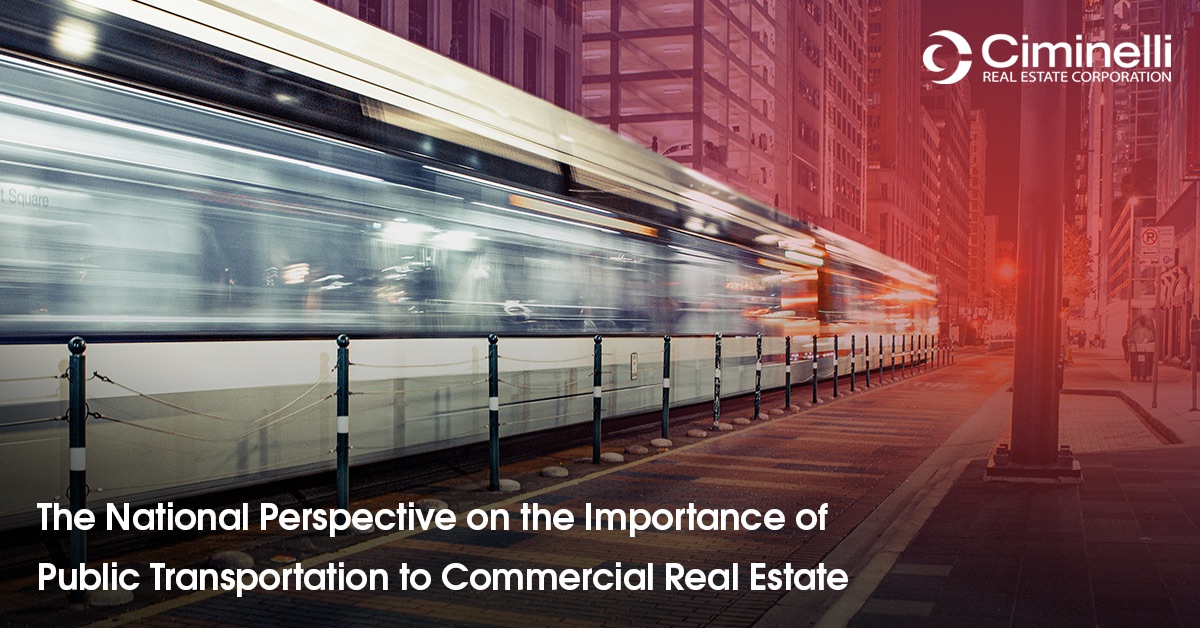The National Importance of Public Transportation to Commercial Real Estate

It seems intuitive that commercial real estate properties proximate to public transportation would be more sought after, and would, therefore, have higher property values and draw higher rental rates. While intuition is important in commercial real estate, facts must always support our thinking. So, let’s take a look at some of the data that confirms a longstanding rule of real estate development: location matters. This axiom is particularly true when it comes to locations and public transportation.
A joint study conducted by the American Public Transportation Association (APTA) and the National Association of Realtors, released in 2019, found that commercial properties that were located within a half-mile radius of public transit services had higher median sale prices than those located farther away.
Based on an examination of real estate prices in seven US cities (Boston, MA; Eugene, OR; Hartford, CT; Los Angeles, CA; Minneapolis-St. Paul, MN; Phoenix, AZ; and Seattle, WA), the report noted that residential sale prices were four to 24 percent higher, and that commercial property values increased five to 42 percent per square foot. In Boston, office sales price increases of 35 percent were attributable to nearby transit availability, while Los Angeles saw a 15 percent increase, and Hartford saw a 14 percent increase for the same reason.
The study rested on results from evaluations of five criteria: residential and commercial sales performance, rent, neighborhood characteristics, local government interventions and housing affordability for properties near transit.
These cities were chosen because they offered a mix of transportation options, including heavy rail, light rail, commuter rail and bus rapid transit. The presence of fixed-guideway public transportation had a particularly “strong correlation” to higher property values. The data from the report also highlighted other benefits to being in close proximity to public transportation: an annual savings of up to $4,400 per household due to lowered transportation costs; better access to jobs; and a reduction in carbon emissions.
Public transit can also increase the development potential of real estate near high-capacity transit lines and stations, which then increases property values. The greatest increase in property value correlates to the development of complex, mixed-use projects at higher densities. This of course, correlates with higher risks and costs for developers, so developers may be hesitant to launch such a project unless other transit-oriented development projects in the community have previously succeeded.
While it is clear that proximity to public transport can increase property values for commercial real estate—what is known as a “transit premium”— the cause and effect relationship is based on several factors. According to Capturing the Value of Transit, a report prepared by Reconnecting America for the Federal Transit Administration, there are three major factors that impact the success of transit-oriented development (TOD) including: local regulatory environment, regional connections and national/regional economics.
Local Regulatory Framework
The local regulatory framework of a city can greatly impact the potential for transit-oriented development. This framework includes zoning ordinances, subdivision regulations, parking ratios and other requirements. The lack of realistic mixed-use zones can significantly limit development unless a TOD overlay district can be set up. A TOD overlay is a floating zone that “implements an array of development regulations that support transit usage” in a zone that would otherwise have restricted such development.
Regional Connections
Ideally, TOD locations should include regional high-capacity transit networks, as opposed to single transit lines that only serve a portion of a metro region. These high-capacity networks provide rapid, direct connections, and serve primarily urban transit riders. The networks also provide additional business-generating connections that increase property value further. As aging or inadequate infrastructures are evaluated and revamped, areas without robust regional networks should plan to incorporate them. Given the positive influence on commercial real estate, developers should support thoughtful inclusion of regional connections into the cities in which they are building.
National and Regional Economics
National and regional economies, and their forecasts, must be considered when planning any commercial real estate venture. TOD development will still draw a transit premium comparative to other new builds, but if the economy is sluggish, or if the area is overbuilt, a significant benefit may not be there.
The real estate market is responding to the national realization of the importance of transit opportunities with respect to location. While a decade ago the industry saw an uptick in property value due to the “Starbucks effect,” now it’s transit availability that is driving up value.
Locally, this is most evident in projects like Ciminelli’s 201 Ellicott, Bethune Lofts, The Mentholatum and The Sinclair. Public transportation availability increases the attractiveness of that commercial real estate, and in turn increases the density of amenities for neighborhood residents, employees in nearby businesses and office buildings, and visitors to the area. It’s clear that transit-oriented development is the future of commercial real estate development.
For more information on Ciminelli’s TOD projects click here.
